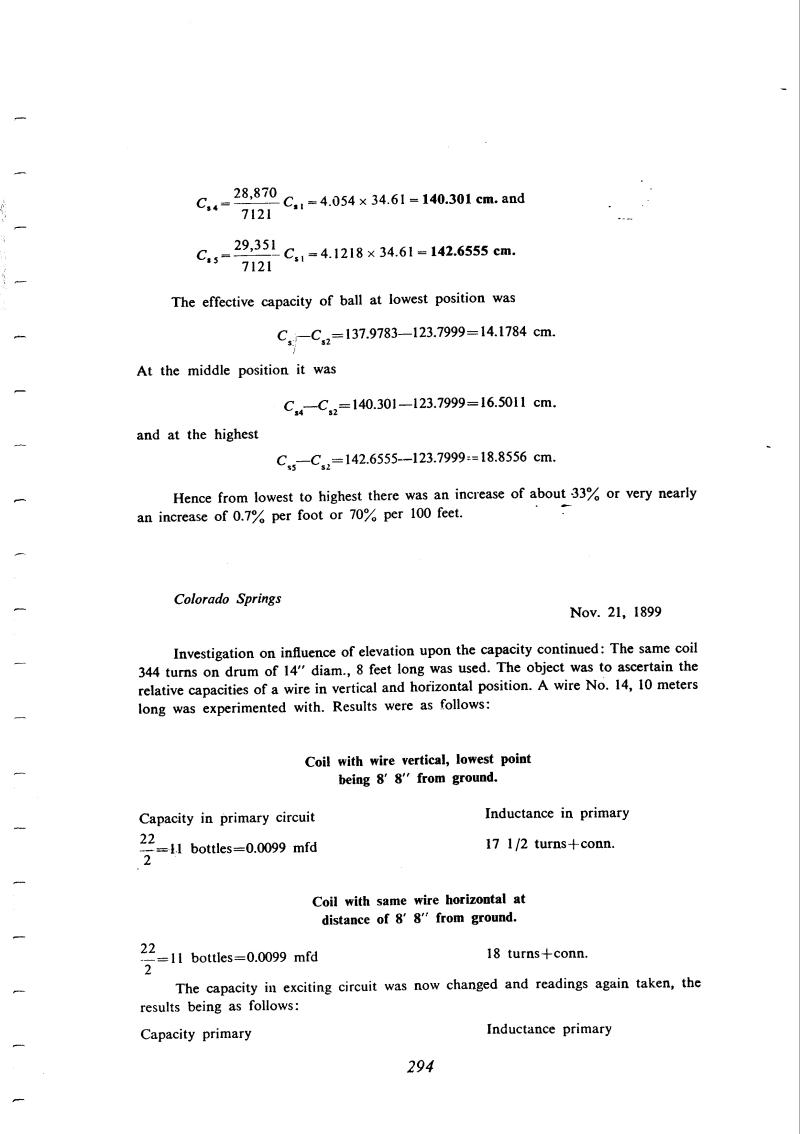
Nikola Tesla Books
Cs4 = $! {28,870 \over 7121} $! Cs1 = 4.054 x 34.61 = 140.301 cm. and
Cs5 = $! {29,351 \over 7121} $! Cs1 = 4.1218 x 34.61 = 142.6555 cm.
The effective capacity of ball at lowest position was
Cs1 - Cs2 = 137.9783 - 123.7999 = 14.1784 cm.
At the middle position it was
Cs4 - Cs2 = 140.301 - 123.7999 = 16,5011 cm.
and at the highest
Cs5 - Cs2 = 142.6555 - 123.7999 = 18.8556 cm.
Hence from lowest to highest there was an increase of about 33% or very nearly an increase of 0.7% per foot or 70% per 100 feet.
Colorado Springs
Nov. 21, 1899
Investigation on influence of elevation upon the capacity continued: The same coil 344 turns on drum of 14" diam., 8 feet long was used. The object was to ascertain the relative capacities of a wire in vertical and horizontal position. A wire No. 14, 10 meters long was experimented with. Results were as follows:
| Coil with wire vertical, lowest point being 8' 8" from ground. | |
| Capacity in primary circuit | Inductance in primary |
| 22/2 = 11 bottles = 0.0099 mfd | 17 1/2 turns + conn. |
| Coil with same wire horizontal at distance of 8' 8" from ground. | |
| 22/2 = 11 bottles = 0.0099 mfd | 18 turns + conn. |
The capacity in exciting circuit was now changed and readings again taken, the results being as follows:
| Capacity primary | Inductance primary |
294
November 21
For some reason which he does not explain, Tesla was interested in the capacity of the same wire when vertical and horizontal, which he measured by the usual resonance method, repeating it with a different capacitance in the primary as a check. Although the results from the two sets of measurements differ appreciably, the value obtained with the wire horizontal was somewhat higher in both cases. The formulae which Tesla used July 24th here yields 54.37 cm for the vertical wire and 58.43 cm for the horizontal. These values agree well with his measurements, especially the first set.
November 21
Tesla determines the capacitance of the same wirelength when it is positioned vertically and horizontally. The measurements were performed by the usual resonant method, and for the purpose of checking he repeated the measurements with two capacitance values in the primary. Although the measurement results in the two series are quite different, in both cases the obtained capacitance is somewhat larger for horizontally positioned wire. By the application of the equation Tesla used on November 16 he obtains the vertical wire capacitance as 54.37 cm. If for the purpose of calculating the electrostatic capacitance of a horizontal conductor the equation for a metal conductor above the metal plane is applied, 58.43 are obtained. When these results* are compared with Tesla's, particularly with the first measurement series, it could be seen that the match is satisfactory.
* The capacitance of a long conductor Tesla calculated on the basis of equation: Ch = $! {L \over 2ln {L \over R}} $! (cm) where L = conductor length in cm, and R = conductor radius in cm.
The thin conductor capacitance above a metal plane at the elevation h cm, and other dimensions as above, is given with(54): Ch = $! {L \over {2ln {2h \over R}}} $! (cm)

